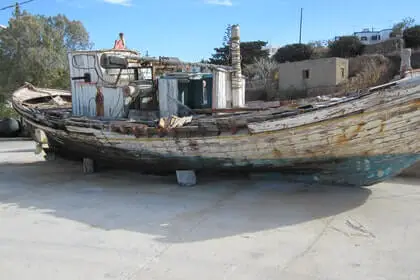Old ships did not have the luxury of advanced technology, so sailors had to get creative when it came to staying warm. There were no electric heaters or space heaters so they made do with what was available.
Sailors onboard old ships would often use a bucket full of heated rocks or hot coals from their cooking fire to stay warm while at sea. In addition, they were known for burning anything that could provide enough heat to keep them alive.
Another way that sailors kept themselves warm at night is by using an iron box oven that is placed in front of an opening in the bulkhead (partition). As long as there are coals inside this oven, it will radiate enough warmth to make a sailor’s bed comfortable all night long.
Some sailors would also bring along a block and tackle system which they could attach to their bunk. Then, they could lower the block and tackle system down to the deck below where firewood is stored.
As sailors would pull up on the rope, it would raise a stack of wood above them. This way, whenever they were cold, they could simply grab two logs from above and throw them into their stove without having to get out of bed.
Did old ships have heating systems?
When the subject of ships is considered, most people are quick to think about modern-day vessels. However, what you may not know is that there have been many incredible advancements in the design and function of ships throughout history.
One example of this advancement can be found in old ship heating system designs. Old ships were usually made with wood. Paint, varnish, and tar were also used to preserve the wood. Due to this, old ships did not have heating systems as they were thought to be fire hazards.
Once a flame became uncontrollable, it swiftly spread and became virtually impossible to contain.

If the ship was very far from shore, this sort of fire was almost certainly a death sentence. This is the major reason why fires on ships were so difficult to control.
It is generally believed that the first shipboard furnaces were introduced late in the 18th century by the French.
These furnaces were created for cooking purposes, but they also provided some heat to sailors who had bunks nearby. A few decades later, steam heating systems were introduced into use onboard ships.
Steam was more controllable than the open fires that were used before. Steam meant automated heating, but it also led to new problems onboard ships.
How did passengers keep warm on sail ships?
In the old days, when people were still trying to figure out how to make a steam engine work, there was no such thing as a heated car or an electric blanket. This meant that in order to keep warm on long journeys by sea, they had to come up with some pretty creative solutions.
These voyagers would take months at a time on the open sea and had no way of knowing what adventures awaited them when they reached their destination.
The conditions on these ships were far from ideal; food was scarce, clean water even more so, and many fell victim to disease or starvation.

One aspect that has not changed over time is that humans need warmth in order to survive.
Sailors kept warm by burning wood or coal in a stove – but how did passengers stay warm? They had it just as rough as the crew members – perhaps even worse. The ship’s captain was responsible for the lives of every man, woman, and child on board his vessel, but that did not mean that they were treated with any more kindness than anyone else.
Passengers could easily freeze to death in their cabins while everyone else crowded around the stove. It was not until the first ocean liners were introduced that there was anywhere warm enough to sleep for all of the passengers.
The first onboard furnaces were created for cooking purposes, but they also provided some heat to sailors who had bunks nearby.
A few decades later, steam heating systems were introduced into use onboard ships. Steam was more controllable than open fires that had previously been used onboard ships.
How did Vikings stay warm on ships?
The Vikings were a group of people from Scandinavia who lived in the cold, harsh conditions of Northern Europe. They had to figure out how to stay warm on their ships so they could cross the ocean and explore new places.
One way was by building a fire underneath the boat, although this did not always work because it created smoke that would choke them all.
Another way was by using animal skins or wool blankets to lay on top of each other for warmth. In some cases, they even used their own body heat as insulation against the cold floorboards below them.

Viking ships were often cold and damp since there was no insulation or heating system on board.
The ships of this period were exposed to the elements and could be a risky place in which to spend the night. More modern ships have structures that cover them and allow for temperatures within the ship’s cabins to remain relatively warm despite being on the open seas, but this was not an option for Vikings who had to make do with what they had around them.
Heating Ships in the 18th and 19th centuries
The process of heating ships in the 18th and 19th centuries was a critical part of the industrial revolution. The need to transport goods quickly over large distances led people to develop new ways of making transportation more efficient, such as building steam engines for locomotives and ships.
One key innovation was heating ships in order to keep sailors alive during long periods at sea.
The idea of creating steam-powered boats is often credited with being one of the most important aspects of modern society. This is it allowed for much faster transportation than sailing ships which could take weeks or months to cross an ocean.
This invention also created a new environment inside the ship where people could live without freezing their bones off or dying from disease or scurvy during winter voyages when they would otherwise have no access to fresh food supplies.
However, before this technology became readily available, other methods for keeping sailors alive on long voyages were developed.
One method was to seal up the ships tightly and prevent the cold from entering inside. This was not always effective, which led many sailors to freeze to death during long voyages.
The most common practice on ships in the 1700s involved burning a lot of wood or coal in a stove aboard the ship which would heat and produce steam from the galley (kitchen). This was still more of a cooking system than a heating system.
The sailors were also below the deck beneath the ship, so the heat coming from the galley didn’t really do them much good.
Where do modern ships get their heat?
Modern ships are now equipped with heating systems that make it possible for sailors to survive even very harsh conditions
Today, oil is used as the primary source of fuel throughout most of the world. This oil heats up water within boilers which then creates steam that powers the engine and takes the ship from point A to point B.
In most cases, the heat from the engine makes it possible for sailors to stay relatively warm during their journey
However, this isn’t always enough for very long voyages where crews may need to be self-sufficient and provide their own power through alternative means such as biofuel or diesel generators that create heat as a byproduct.
During the colder days of the year, many ships have heating systems that can be used to ensure everyone on board stays warm throughout their journey.
For smaller vessels such as those in the fishing fleet, it may not be possible to create large amounts of heat through burning oil or coal due to safety reasons and cost.
Often, these smaller ships rely on biofuels to power their heating system which can be used in small amounts without dramatically impacting the boat’s fuel supply
The use of biofuel that is produced from recycled materials or other biological byproducts allows sailors to stay warm even when stranded in cold waters without carrying too much additional weight for fuel.




